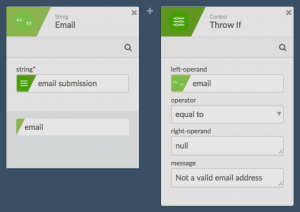Combine text you type and fields you drag and drop in. At runtime, all of the text is combined with the values of the fields to generate a single text output.
For instance, you might compose an email by starting with the following text:
Dear ,
This is a reminder to please pay the following bill:
Invoice number:
Date:
Amount:
Thank you.
And then you can insert fields from earlier in your Flow that have the appropriate values for name, invoice number, date, and amount. Drag and drop each field to where the cursor is directly over the position in the text where you want to insert the field. The function will generate a single output that, for this example, you can pass directly into the action that sends an email.
After fields have been inserted, you can click and drag to move them. To delete a field, click to the right of the field and then use Delete or Backspace.
ADVANCED USER TIP: The Compose function is good at “cleaning up” text fields that may be typed incorrectly. For example, if you do a HTTP Get from an API that sometimes returns text and sometimes returns numbers, then that output field can lead to runtime errors in your Flow. If you pass a field into Compose that was incorrectly typed, the Compose function will convert it to text without error.
The function has one large input area that accepts a combination of text you type and fields you drag/drop in.
Output Fields
output - the result of combining the text with the values of the fields

